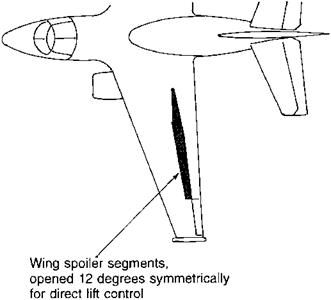Direct Lift Control
Direct lift control, in which airplane lift is modulated to correct flight path errors without changing airplane angle of attack, seems to be a natural solution to carrier-approach path control problems. According to William Koven, the first proposal for direct lift control on carrier airplanes came from Douglas E. Drake, a Douglas Aircraft engineer and former Navy pilot. Professor Edward Seckel directed follow-up studies at Princeton University. Direct lift control was first tested on a carrier-based airplane in 1964. This was a Ling – Temco-Vought F-8C, modified for the ailerons to act as variable flaps. That work was done by J. D. Etheridge and C. E. Mattlage.
The production Lockheed S-3A Viking has direct lift control, to aid in carrier landing approaches. On the S-3A, quite rapid flight path corrections are made by moving both wing spoilers, changing wing lift without changing the angle of attack (Figure 12.4). With direct lift control there is no need to wait for the airplane to respond in pitch to elevator motion, a response that takes place at the short-period pitching frequency of the airplane. A button on the S-3A pilot’s yoke commands symmetric spoiler deflection.
In contrast to the relatively crude button-operated S-3A direct lift control system, a sophisticated, integrated, direct lift system is used on the Lockheed 1011 Tristar, which is fitted with the Collins FCS-240 digital automatic pilot. This Collins system, incorporating
|
Figure 12.4 Direct lift control using wing spoilers provide satisfactory path control for carrier landings on the Lockheed S-3A Viking. (From Jane’s All the World’s Aircraft) |
automatic landings or autoland, was originally developed for the L-1011 ’s European market, where the winter months require frequent low-visibility landings. The FAA certified the L-1011 for Category IIIA (ceiling zero, visibility 700 feet) landings in 1981.
When the pilot selects landing flaps the four inboard wing spoiler segments are rigged up to an 8-degree position. They are then modulated upward and downward from the up-rigged position to obtain direct lift control. Spoiler angle changes from the up-rigged position are commanded by the cockpit control column moved either by the pilot or the autopilot’s autoland mode, in the normal sense. That is, back control column motion closes the spoilers and the airplane gains altitude.
If a control column adjustment is sustained for several seconds, the spoiler segment deflections from their up-rigged positions are gradually washed out and a corresponding adjustment is made to the horizontal tail angle. In the case of a sustained rearward control column motion, the washout moves the spoilers back up to their up-rigged positions of 8 degrees and the horizontal tail angle is increased in the airplane nose-up sense. The Tristar’s period in the short-period pitching mode is a full 8 seconds at landing approach airspeeds. Pitch and path corrections by horizontal tail control alone would take place at that modal period, or rather slowly. Direct lift control provides a faster path response for demanding all-weather manual or automatic landings. In contrast to the S-3A case where the pilot controls vertical path with the direct lift button as well as control column motion, in the integrated L-1011 case there is only one pilot controller, the control column.
What is missing in considering direct lift control for any airplane, carrier – or land-based, is a method that determines when that feature is needed. What combinations of pitch and thrust responses are such that direct lift control is required to meet specific vertical path control requirements?












